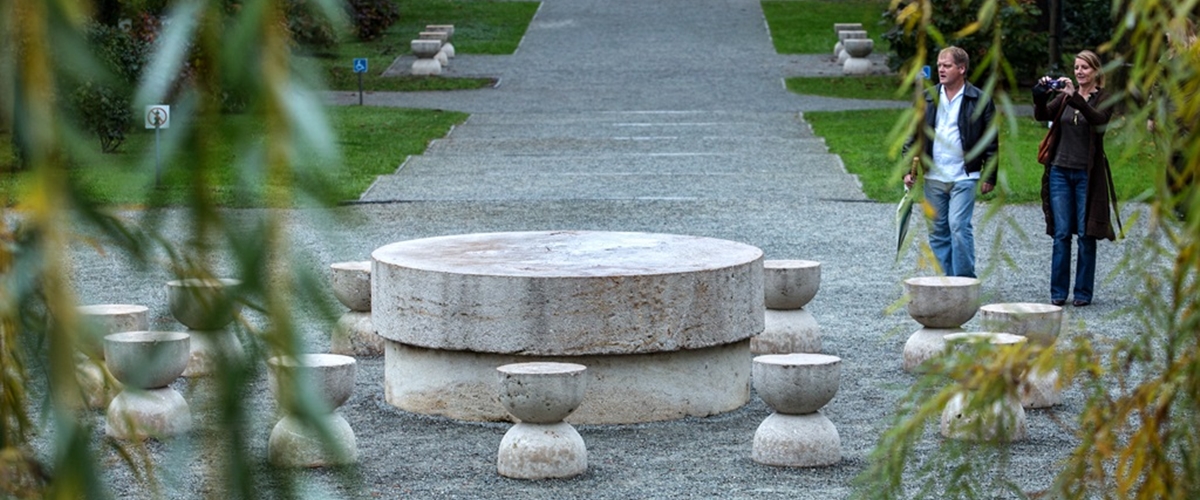Constantin Brancusi
Constantin Brancusi - pioneer of modern abstract sculpture.
The Table of Silence, The Kiss Gate and the Endless Column – these are the three sculptural components from Targu-Jiu, made by Constantin Brancusi, which constitutes an homage to the hero soldiers fallen during the First World War. The initiative of achieving this ensemble belonged to Aretia Tatarascu, in 1937.
The three sculptural elements are disposed on an axis 1,275 meters long, oriented from West to East, in the Central Park.
The Table of Silence (Masa Tacerii) is made in limestone and it has the following dimensions: panel diameter 2, 15 meters, thick 0,43 m and the leg is 2 m in diameter and 0,45 m thick. According to the exegetes of the Brancusian art, the Table of Silence represents the table around which gather the soldiers before confronting their enemy. At the same time, the chairs stand for the time disposed in hourglasses. Some make an analogy with The Last Supper of Leonardo da Vinci.
Next comes the Chairs Alley representing those who participate without any implication, waiting for the end.
The Kiss Gate – Constantin Brancusi.
The Kiss Gate (Poarta Sarutului) is the second element of the ensemble. Technically speaking, it is 5,13 m high, 5,45 m long and the pillars have 1,69 m width. This time, the material used was Banpotoc travertine and in order to achieve the Gate, Brancusi was helped by two stone carvers: Ion Alexandrescu from Bucharest and Golea from Dobrita. It’s significance is very simple: the Kiss Gate makes the transition to another life, and the motif on the pillars stands for the eyes looking inside.
The Endless Column (Coloana Infinitului) or the Column of Gratitude 29,33 m high, is the third element of the ensemble, being situated at the eastern extremity of the axis forming the Alley of Heroes. The column is made out of 17 rhomboidal cast iron modules, measuring 1,80 m high each and about 860 kg, moulded in the Central Workshop from Petrosani. The modules are fixed on a steel axis. The one who ethnically coordinated the assembling of the column was the engineer Stefan Georgescu-Gorjan.
Otherwise, the Endless Column is considered to be the “spiritual will” of Constantin Brancusi.
Some exegetes of the Brancusian art consider it necessary to complete the image of the Ensemble, between the Kiss Gate and the Column, with the waters of the river Jiu, running nearby, and then with The Heroes’ Way representing the way of the souls of “heroes soldiers” and also with the Church “Sfintii Apostoli”, the place where takes place the purification and the passage to the non-being.
The whole ensemble from Targu-Jiu was inaugurated on October 27th, 1938.
Unfortunately, for almost 25 years, all three elements were abandoned because of the fact that the political power of that age considered Brancusi as a representative of the bourgeoisie. Only 7 years after his death, in 1964, did initiate the process of rearrangement and consolidation of the Ensemble.
After 1989, the monumental Ensemble from Targu Jiu was enlisted in the European heritage, alongside with the Romanian Athenaeum, the Fortress of Histria and the Cantacuzino Palace.
His operas are to be found in the city of Targu Jiu, located at 290 km from Bucharest, and very close to the mountainside.
Travel offers for Constantin Brancusi




.png)



